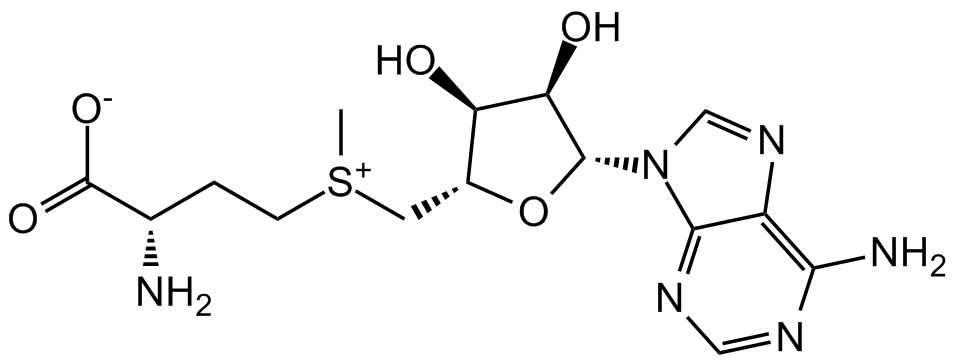
Chemical Structure
S-Adenosylmethionine
CDX-A0247
CAS Number29908-03-0
Product group Chemicals
Estimated Purity>95%
Molecular Weight398.44
Overview
- SupplierChemodex
- Product NameS-Adenosylmethionine
- Delivery Days Customer10
- CAS Number29908-03-0
- CertificationResearch Use Only
- Estimated Purity>95%
- Molecular FormulaC15H22N6O5S
- Molecular Weight398.44
- Scientific DescriptionChemical. CAS: 29908-03-0. Formula: C15H22N6O5S. MW: 398.44. S-Adenosylmethionine (SAM) is the first product of the methionine cycle and is implicated in the synthesis of polyamines and in the transsulfuration pathway leading to homocysteine and reduced glutathione (GSH) biosynthesis. SAM is synthesized from methionine and ATP in a reaction catalyzed by methionine adenosyltransferases (MATs). These enzymes are encoded by two genes, MAT1A and MAT2A. SAM plays an essential role as methyl-donor for the methylation reactions during which it is transformed to S-adenosylhomocysteine (SAH). SAH, a strong inhibitor of transmethylations, is transformed to homocysteine (HCY) by a specific hydroxylase. The methionine cycle plays a fundamental role in the cellular metabolism and the alteration of its functionality causes important disorders linked to modification of DNA methylation and gene expression, redox imbalance and metabolic reprogramming in liver and brain. More than 40 methyl transfers from SAM are known, to various substrates such as nucleic acids, proteins, lipids and secondary metabolites. In bacteria, SAM is bound by the SAM riboswitch, which regulates genes involved in methionine or cysteine biosynthesis. In eukaryotic cells, SAM serves as a regulator of a variety of processes including DNA, tRNA, and rRNA methylation; immune response; amino acid metabolism; transsulfuration; and more. In plants, SAM is crucial to the biosynthesis of ethylene, an important plant hormone and signaling molecule. SAM is a dietary supplement with potent antidepressant effects, and has the potential for liver disease and osteoarthritis research. - S-Adenosylmethionine (SAM) is the first product of the methionine cycle and is implicated in the synthesis of polyamines and in the transsulfuration pathway leading to homocysteine and reduced glutathione (GSH) biosynthesis. SAM is synthesized from methionine and ATP in a reaction catalyzed by methionine adenosyltransferases (MATs). These enzymes are encoded by two genes, MAT1A and MAT2A. SAM plays an essential role as methyl-donor for the methylation reactions during which it is transformed to S-adenosylhomocysteine (SAH). SAH, a strong inhibitor of transmethylations, is transformed to homocysteine (HCY) by a specific hydroxylase. The methionine cycle plays a fundamental role in the cellular metabolism and the alteration of its functionality causes important disorders linked to modification of DNA methylation and gene expression, redox imbalance and metabolic reprogramming in liver and brain. More than 40 methyl transfers from SAM are known, to various substrates such as nucleic acids, proteins, lipids and secondary metabolites. In bacteria, SAM is bound by the SAM riboswitch, which regulates genes involved in methionine or cysteine biosynthesis. In eukaryotic cells, SAM serves as a regulator of a variety of processes including DNA, tRNA, and rRNA methylation; immune response; amino acid metabolism; transsulfuration; and more. In plants, SAM is crucial to the biosynthesis of ethylene, an important plant hormone and signaling molecule. SAM is a dietary supplement with potent antidepressant effects, and has the potential for liver disease and osteoarthritis research.
- SMILESC[S+](C[C@@H]1[C@@H](O)[C@@H](O)[C@H](N2C=NC3=C(N)N=CN=C32)O1)CC[C@H](N)C([O-])=O
- Storage Instruction-20°C
- UNSPSC12352200

![S-Adenosyl-L-methionine [29908-03-0]](https://www.targetmol.com/group3/M00/35/64/CgoaEGayHdSEW628AAAAAK5mE2I223.png)
